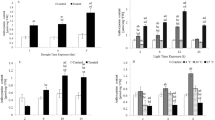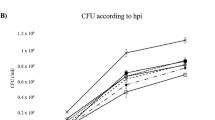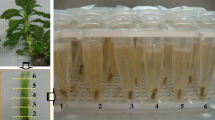Abstract
In order to explore the relationship between sclerotial formation and antioxidant enzymes under abiotic stresses, the effects of abiotic stresses including temperature, pH value, osmotic pressure, limited nitrogen, and hydrogen peroxide (H2O2) on the activities of antioxidant enzymes, ascorbate peroxidase (APX), superoxide dismutase (SOD), peroxidase (POD), and catalase (CAT) in Pleurotus tuber-regium were studied. Meanwhile, the sclerotial formation under these abiotic stress conditions was also investigated. It was found that low temperature, weak alkaline, appropriate osmotic stress, and H2O2 can promote sclerotial formation, and sclerotial formation always tended to occur when the activities of antioxidant enzymes were at a high value. During the prolonged low temperature stress, SOD acted mainly in the early stage of stress, while POD and CAT had higher activity in the middle and late stage. Moreover, the reverse transcription quantitative polymerase chain reaction (RT-qPCR) results showed that SOD.193 and POD.535 were significantly down-regulated in sclerotia, and CAT.1115 and POD.401 were up-regulated instead. These antioxidant enzyme genes played an important role in the sclerotial formation under low temperature stress. It is strongly suggested that antioxidant enzymes and abiotic stresses are closely related to sclerotial formation in P. tuber-regium.
Key points
• Low temperature and H2O2 can promote sclerotial formation.
• Sclerotia are more likely to form under high antioxidant enzyme activity.
• POD.401, POD.535, SOD.193, and CAT.1115 are important for sclerotial formation.





Similar content being viewed by others
Data Availability
All data generated or analyzed during this study are included in this published article.
References
Alhallaf W, Perkins LB (2022) The anti-inflammatory properties of chaga extracts obtained by different extraction methods against LPS-induced RAW 264.7. Molecules 27(13):4207. https://doi.org/10.3390/molecules27134207
Amir R, Levanon D, Hadar Y, Chet I (1992) Formation of sclerotium by Morchella esculenta: relationship between media composition and turgor potential in the mycelium. Microbiol Res 96(11):943–948. https://doi.org/10.1016/S0953-7562(09)80595-9
Beers RF, Sizer IW (1952) A spectrophotometric method for measuring the breakdown of hydrogen peroxide by catalase. J Biol Chem 195(1):133–140. https://doi.org/10.1016/S0731-7085(00)00592-6
Caverzan A, Casassola A, Brammer SP (2016) Reactive oxygen species and antioxidant enzymes involved in plant tolerance to stress. In: Oliveira AB (ed) Abiotic and biotic stress in plants. Intech, London, UK, pp 463–480
Chance B, Maehly AC (1955) Assay of catalases and peroxidases. Meth Enzymol 2:764–775. https://doi.org/10.1016/S0076-6879(55)02300-8
Cheng Q, Hu CX, Jia W, Cai MM, Zhao YY, Tang YN, Yang DD, Zhou YJ, Sun XC, Zhao XH (2019) Selenium reduces the pathogenicity of Sclerotinia sclerotiorum by inhibiting sclerotium formation and germination. Ecotoxicol Environ Saf 183:109503. https://doi.org/10.1016/j.ecoenv.2019.109503
Coley-Smith JR, Cooke RC (1971) Survival and germination of fungal sclerotium. Annu Rev Phytopathol 9(1):65–92. https://doi.org/10.1146/annurev.py.09.090171.000433
Fan LL, Yong ML, Li DY, Liu YJ, Lai CH, Chen HM, Cheng FM, Hu DW (2016) Effect of temperature on the development of sclerotia in Villosiclava virens. J Integr Agric 15(11):2550–2555. https://doi.org/10.1016/s2095-3119(16)61400-4
Gechev T, Petrov V (2020) Reactive oxygen species and abiotic stress in plants. Int J Mol Sci 21(20):7433. https://doi.org/10.3390/ijms21207433
Georgiou CD, Patsoukis Ν, Papapostolou Ι, Zervoudakis G (2006) Sclerotial metamorphosis in filamentous fungi is induced by oxidative stress. Integr Comp Biol 46(6):691–712. https://doi.org/10.1093/icb/icj034
Gratao PL, Polle A, Lea PJ, Azevedo RA (2005) Making the life of heavy metal-stressed plants a little easier. Funct Plant Biol 32(6):481–494. https://doi.org/10.1071/FP05016
Hou Y, Na R, Li M, Jia R, Zhou H, Jing L, Zhao J (2017) H2O2 is involved in cAMP-induced inhibition of sclerotia initiation and maturation in the sunflower pathogen Sclerotinia sclerotiorum. J Plant Pathol 99(1):17–26. https://doi.org/10.4454/jpp.v99i1.3771
Janero DR (1990) Malondialdehyde and thiobarbituric acid-reactivity as diagnostic indexes of lipid-peroxidation and peroxidative tissue-injury. Free Radical Bio Med 9(6):515–540. https://doi.org/10.1016/0891-5849(90)90131-2
Jiang YF, Jin MY, Zhou XW (2021) Research progress on Wolfiporia cocos polysaccharides and their immunoregulatory functions. Acta Edulis Fungi 28(2):130–139. https://doi.org/10.16488/j.cnki.1005-9873.2021.02.017. (in Chinese with an English abstract)
Lin SL, Wang PX, Lam KL, Hu JM, Cheung PCK (2020) Research on a specialty mushroom (Pleurotus tuber-regium) as a functional food: chemical composition and biological activities. J Agric Food Chem 68(35):9277–9286. https://doi.org/10.1021/acs.jafc.0c03502
Liu B, Ma ZJ, Gai XT, Sun YQ, Wang YF, He SD, Gao ZG (2018a) Analysis of putative sclerotia maturation-related gene expression in Rhizoctonia solani AG1-IA. Arch Biol Sci 70(4):647–653. https://doi.org/10.2298/abs180106026l
Liu QZ, Zhao ZH, Dong H, Dong CH (2018b) Reactive oxygen species induce sclerotial formation in Morchella importuna. Appl Microbiol Biot 102(18):7997–8009. https://doi.org/10.1007/s00253-018-9104-4
Liu XW, Xu XF, Liu W, Zhao YP, Zhang SW, Shen YN, Yang JG (2021) Research progress on extraction, structure, activity and mechanism of Poria cocos-derived polysaccharides. Food Res Dev 42(8):172–178. https://doi.org/10.12161/j.issn.1005-6521.2021.08.028. (in Chinese with an English abstract)
Ma F, Chen P, Zhou Q, Sun S (2018) Evaluation on intrinsic quality of Wolfiporia cocos influenced by cultivation methods by a multi-step IR macro-fingerprinting technique. J Mol Struct 1165:23–27. https://doi.org/10.1016/j.molstruc.2018.03.062
Marklund S, Marklund G (1974) Involvement of the superoxide anion radical in the autoxidation of pyrogallol and a convenient assay for superoxide dismutase. J Biochem 47(3):469–474. https://doi.org/10.1111/j.1432-1033.1974.tb03714.x
Nakano Y, Asada K (1981) Hydrogen peroxide is scavenged by ascorbate-specific peroxidase in spinach chloroplasts. Plant Cell Physiol 22(5):867–880. https://doi.org/10.1093/oxfordjournals.pcp.a076232
Nallathamby N, Phan CW, Seow SLS, Baskaran A, Laskshmanan H, Malek NA, Sabaratnam V (2018) A status review of the bioactive activities of tiger milk mushroom Lignosus rhinocerotis (Cooke) Ryvarden. Front Pharmacol 8:998. https://doi.org/10.3389/fphar.2017.00998
Papapostolou I, Georgiou CD (2010a) Hydrogen peroxide is involved in the sclerotial differentiation of filamentous phytopathogenic fungi. J Appl Microbiol 109(6):1929–1936. https://doi.org/10.1111/j.1365-2672.2010.04822.x
Papapostolou I, Georgiou CD (2010b) Superoxide radical induces sclerotial differentiation in filamentous phytopathogenic fungi: a superoxide dismutase mimetics study. Microbiology 156(3):960–966. https://doi.org/10.1099/mic.0.034579-0
Papapostolou I, Georgiou CD (2010c) Superoxide radical is involved in the sclerotial differentiation of filamentous phytopathogenic fungi: identification of a fungal xanthine oxidase. Fungal Biol 114(5–6):387–395. https://doi.org/10.1016/j.funbio.2010.01.010
Pasailiuk MV (2021) Low temperature induces Polyporus umbellatus sclerotia formation on nutrient media. AJOM 4(1):274–278. https://doi.org/10.5943/ajom/4/1/10
Pedrol NP, Tamayo PR (2001) Protein content quantification by Bradford method. In: Reigosa MJ (ed) Handbook of plant ecophysiology techniques. Kluwer academic, Dordrecht, The Netherlands, pp 283–295
Razavizadeh R, Adabavazeh F (2017) Effects of sorbitol on essential oil of Carum copticum L. under in vitro culture. Rom Biotechnol Lett 22(1):12281–12289
Segal LM, Wilson RA (2018) Reactive oxygen species metabolism and plant-fungal interactions. Fungal Genet Biol 110:1–9. https://doi.org/10.1016/j.fgb.2017.12.003
Senapati M, Tiwari A, Sharma N, Chandra P, Bashyal BM, Ellur RK, Bhowmick PK, Bollinedi H, Vinod KK, Singh AK, Krishnan SG (2022) Rhizoctonia solani Kühn pathophysiology: status and prospects of sheath blight disease management in rice. Front Plant Sci 13:881116. https://doi.org/10.3389/fpls.2022.881116
Sideri M, Georgiou CD (2000) Differentiation and hydrogen peroxide production in Sclerotium rolfsii are induced by the oxidizing growth factors, light and iron. Mycologia 92(6):1033–1042. https://doi.org/10.2307/3761468
Sies H (2017) Hydrogen peroxide as a central redox signaling molecule in physiological oxidative stress: Oxidative eustress. Redox Biol 11:613–619. https://doi.org/10.1016/j.redox.2016.12.035
Silva LR, Rodrigues LLD, Zacaroni AB, Castro BS, Sifuentes DN, Botelho AS, Moraes MCB, Mello SCM (2022) Sclerotium rolfsii mycelial profile analysis by MALDI-TOF related to biological control, volatile organic compounds diversity and onion growth promotion, as influenced by Trichoderma spp. Biol Control 172:104970. https://doi.org/10.1016/j.biocontrol.2022.104970
Smith ME, Henkel TW, Rollin JA (2015) How many fungi make sclerotium? Fungal Ecol 13:211–220. https://doi.org/10.1016/j.funeco.2014.08.010
Sudhakar C, Lakshmi A, Giridarakumar S (2001) Changes in the antioxidant enzyme efficacy in two high yielding genotypes of mulberry (Morus alba L.) under NaCl salinity. Plant Sci 161(3):613–619. https://doi.org/10.1016/S0168-9452(01)00450-2
Sun XY, Liu DM, Wang YY, Ma AM (2020) Biogenesis of macrofungal sclerotium: influencing factors and molecular mechanisms. Appl Microbiol Biot 104(10):4227–4234. https://doi.org/10.1007/s00253-020-10545-8
Sun XY, Wu JY, Mo CY, Ma AM (2021) Selection and validation of endogenous reference genes for RT-qPCR normalization in different stresses and tissues of the tiger milk mushroom. Pleurotus Tuber-regium. Mycoscience 62(5):281–288. https://doi.org/10.47371/mycosci.2021.05.001
Sun XY, Wu JY, Zhang SH, Luo L, Mo CY, Sheng L, Ma AM (2022) Genome and comparative transcriptome dissection provide insights into molecular mechanisms of sclerotium formation in culinary-medicinal mushroom Pleurotus tuber-regium. Front Microbiol 12:815954. https://doi.org/10.1007/s00253-020-10545-8
Van der Vliet A, Janssen-Heininger YM (2014) Hydrogen peroxide as a damage signal in tissue injury and inflammation: murderer, mediator, or messenger? J Cell Biochem 115(3):427–435. https://doi.org/10.1002/jcb.24683
Wang H, Liu B, Ma Z, Ma ZJ, Yao Y, Sun Y, Gao Z (2019) Cloning and the expression analysis in sclerotium formation of RsCAT in Rhizoctonia solani. J Maize Sci 27(4):175–180. https://doi.org/10.13597/j.cnki.maize.science.20190426. (in Chinese with an English abstract)
Warris A, Ballou ER (2019) Oxidative responses and fungal infection biology. Semin Cell Dev Biol 89:34–46. https://doi.org/10.1016/j.semcdb.2018.03.004
Wasser SP (2011) Current findings, future trends, and unsolved problems in studies of medicinal mushrooms. Appl Microbiol Biot 89(5):1323–1332. https://doi.org/10.1007/s00253-010-3067-4
Weiner J (1978) Determination of total carbohydrate content in beer. J Inst Brew 84(4):222–223. https://doi.org/10.1002/j.2050-0416.1978.tb03876.x
Wong KH, Cheung PCK, Wu JZ (2003) Biochemical and microstructural characteristics of insoluble and soluble dietary fiber prepared from mushroom sclerotium of Pleurotus tuber-regium, Polyporus rhinocerus, and Wolfiporia cocos. J Agric Food Chem 51(24):7197–7202. https://doi.org/10.1021/jf034195g
Xing YM, Chen J, Song C, Liu YY, Guo SX, Wang CL (2013a) Nox gene expression and cytochemical localization of hydrogen peroxide in Polyporus umbellatus sclerotium formation. Int J Mol Sci 14(11):22967–22981. https://doi.org/10.3390/ijms141122967
Xing YM, Zhang LC, Liang HQ, Lv J, Song C, Guo SX, Wang CL (2013) Sclerotial formation of Polyporus umbellatus by low temperature treatment under artificial conditions. PLoS One 8(2):e56190. https://doi.org/10.1371/journal.pone.0056190
Yin WQ, Guo SX, Xing YM, Xing XK (2012) A new method to induce sclerotium differentiation in Polyporus umbellatus by split-plate culture. Mycol Prog 11(4):957–960. https://doi.org/10.1007/s11557-011-0802-x
You J, Chan ZL (2015) ROS regulation during abiotic stress responses in crop plants. Front Plant Sci 6:1092–1106. https://doi.org/10.3389/fpls.2015.01092
Funding
This research was supported by a grant from the National Natural Science Foundation of China (31772375) to Aimin Ma.
Author information
Authors and Affiliations
Contributions
All authors contributed to this study. LS and AM conceived and designed experiments. LS conducted the research and wrote the manuscript. XS, CM, MH, XW, and AM critically reviewed the manuscript.
Corresponding author
Ethics declarations
Ethical approval
This article does not contain any studies with human participants or animals performed by any of the authors.
Conflict of interest
The authors declare no competing interests.
Additional information
Publisher's note
Springer Nature remains neutral with regard to jurisdictional claims in published maps and institutional affiliations.
Rights and permissions
Springer Nature or its licensor (e.g. a society or other partner) holds exclusive rights to this article under a publishing agreement with the author(s) or other rightsholder(s); author self-archiving of the accepted manuscript version of this article is solely governed by the terms of such publishing agreement and applicable law.
About this article
Cite this article
Sheng, L., Sun, X., Mo, C. et al. Relationship between antioxidant enzymes and sclerotial formation of Pleurotus tuber-regium under abiotic stress. Appl Microbiol Biotechnol 107, 1391–1404 (2023). https://doi.org/10.1007/s00253-022-12358-3
Received:
Revised:
Accepted:
Published:
Issue Date:
DOI: https://doi.org/10.1007/s00253-022-12358-3




